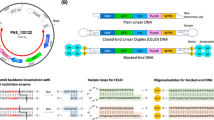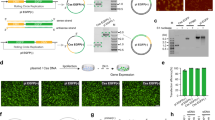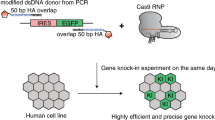Abstract
Minicircles are a new form of supercoiled DNA molecule for nonviral gene transfer which have neither bacterial origin of replication nor antibiotic resistance marker. They are thus smaller and potentially safer than the standard plasmids currently used in gene therapy. They were obtained in E. coli by att site-specific recombination mediated by the phage λ integrase, which was used to excise the expression cassette from the unwanted plasmid sequences. We produced two minicircles containing the luciferase or β-galactosidase gene under the control of the strong human cytomegalovirus immediate–early enhancer/promoter. Comparing maximal differences, these minicircles gave 2.5 to 5.5 times more reporter gene activity than the unrecombined plasmid in the NIH3T3 cell line and rabbit smooth muscle cells. Moreover, injection in vivo into mouse cranial tibial muscle, or human head and neck carcinoma grafted in nude mice resulted in 13 to 50 times more reporter gene expression with minicircles than with the unrecombined plasmid or larger plasmids. Histological analysis in muscle showed there were more transfected myofibers with minicircles than with unrecombined plasmid.
This is a preview of subscription content, access via your institution
Access options
Subscribe to this journal
Receive 12 print issues and online access
$259.00 per year
only $21.58 per issue
Buy this article
- Purchase on Springer Link
- Instant access to full article PDF
Prices may be subject to local taxes which are calculated during checkout







Similar content being viewed by others
References
Darquet AM et al. A new DNA vehicle for nonviral gene delivery: supercoiled minicircle Gene Therapy 1997 4: 1341–1349
Pang A . Production of antibodies against Bacillus thuringiensis delta-endotoxin by injecting its plasmids Biochem Biophys Res Commun 1994 202: 1227–1234
Valera A, Perales J, Hatzoglou M, Bosch F . Expression of the neomycin-resistance (neo) gene induces alterations in gene expression and metabolism Hum Gene Ther 1994 5: 449–456
Klinman D, Yamshchikov G, Ishigatsubo Y . Contribution of CpG motifs to the immunogenicity of DNA vaccines J Immunol 1997 158: 3635–3639
Pisetsky D . The immunologic properties of DNA J Immunol 1994 156: 421–423
Sato Y et al. Immunostimulatory DNA sequences necessary for effective intradermal gene immunization Science 1996 273: 352–354
Landy A . Dynamic, structural, and regulatory aspects of lambda site-specific recombination Annu Rev Biochem 1989 58: 913–949
Hasan N, Szybalski W . Control of cloned gene expression by promoter inversion in vivo: construction of improved vectors with a multiple cloning site and the Ptac promoter Gene 1987 56: 145–151
Gellert M, Nash H . Communication between segments of DNA during site-specific recombination Nature 1987 325: 401–404
Davis H et al. Plasmid DNA is superior to viral vectors for direct gene transfer into adult mouse skeletal muscle Hum Gene Ther 1993 4: 733–740
Buttrick P, Kass A, Kitsis R . Behavior of genes directly injected into the rat heart in vivo Circ Res 1992 70: 193–198
Ledley F . Non viral gene therapy: the promise of genes as pharmaceutical products Hum Gene Ther 1995 6: 1129–1144
Jain R . Transport of molecules in the tumor interstitium: a review Cancer Res 1987 47: 3039–3051
Levy M, Barron L, Meyer K, Szoka FJ . Characterization of plasmid DNA transfer into mouse skeletal muscle: evaluation of uptake mechanism, expression and secretion of gene products into blood Gene Therapy 1996 3: 201–211
Wolff J et al. Expression of naked plasmids by cultured myotubes and entry of plasmids into T tubules and caveolae of mammalian skeletal muscle J Cell Sci 1992 103: 1249–1259
Friend D, Papahadjopoulos D, Debs R . Endocytosis and intracellular processing accompanying transfection mediated by cationic liposomes Biochim Biophys Acta 1996 1278: 41–50
Zabner J et al. Cellular and molecular barriers to gene transfer by a cationic lipid J Biol Chem 1995 270: 18997–19007
Gao X, Huang L . Cationic liposome-mediated gene transfer Gene Therapy 1995 2: 710–722
Danko I et al. Pharmacological enhancement of in vivo foreign gene expression in muscle Gene Therapy 1994 1: 114–121
Dworetzky S, Lanford R, Feldherr C . The effects of variations in the number and sequence of targeting signals on nuclear uptake J Cell Biol 1988 107: 1279–1287
Lanford R, Kanda P, Kennedy R . Induction of nuclear transport with a synthetic peptide homologous to the SV40 T antigen transport signal Cell 1986 46: 575–582
Wils P et al. Efficient purification of plasmid DNA for gene transfer using triple-helix affinity chromatography Gene Therapy 1997 4: 323–330
Sambrook J, Fritsh E, Maniatis T . Molecular Cloning: a Laboratory Manual Cold Spring Harbor Laboratory Press: New York 1989
Sanger F et al. Nucleotide sequence of bacteriohage λ DNA J Mol Biol 1982 162: 729–773
Yanisch-Perron C, Vieira J, Messing J . Improved M13 phage cloning vectors and host strains: nucleotide sequences of the M13mp18 and pUC19 vectors Gene 1985 33: 103–119
Tanaka M, Herr W . Differential transcriptional activation by Oct-1 and Oct-2: interdependent activation domains induce Oct-2 phosphorylation Cell 1990 60: 375–386
Manthorpe M et al. Gene therapy by intramuscular injection of plasmid ADN: studies on firefly luciferase gene expression in mice Hum Gene Ther 1993 4: 419–431
Sadler J, Tecklenburg M, Betz J . Plasmids containing many tandem copies of a synthetic lactose operator Gene 1980 8: 279–300
Chamley J, Campbell G, McConnell J, Groschel-Stewart U . Comparison of vascular smooth muscle cells from adult human, monkey and rabbit in primary culture and in subculture Cell Tissue Res 1977 177: 503–522
Byk G et al. Synthesis, activity, and structure-activity relationship studies of novel cationic lipids for DNA transfer J Med Chem 1998 41: 224–235
Escriou V et al. Cationic lipid-mediated gene transfer: effectof serum on cellular uptake and intracellular fate of lipopolyamine/DNA complexes Biochim Biophys Acta 1998 1368: 276–288
Wiechelman K, Braun R, Fitzpatrick J . Investigation of the bicinchoninic acid protein assay: identification of the groups responsible for color formation Anal Biochem 1988 175: 231–237
Wolff J et al. Conditions affecting direct gene transfer into rodent muscle in vivo Biotechniques 1991 11: 474–485
Cohen-Tannoudji M, Morello D, Babinet C . Unexpected position-dependent expression of H-2 and beta 2-micro-globulin/lacZ transgenes Mol Reprod Dev 1992 33: 149–159
Davis H, Whalen R, Demeneix B . Direct gene transfer into skeletal muscle in vivo: factors affecting efficiency of transfer and stability of expression Hum Gene Ther 1993 4: 151–159
Tissenbaum HA, Parry DJ . The effect of partail denervation of tibialis anterior (TA) muscle on the number and size of motorneurons in TA motornucleus of normal and dystrophic (C57BL dy2j/dy2j) mice Can J Physiol Pharmacol 1991 69: 1769–1773
Author information
Authors and Affiliations
Rights and permissions
About this article
Cite this article
Darquet, AM., Rangara, R., Kreiss, P. et al. Minicircle: an improved DNA molecule for in vitro and in vivo gene transfer. Gene Ther 6, 209–218 (1999). https://doi.org/10.1038/sj.gt.3300816
Received:
Accepted:
Published:
Issue Date:
DOI: https://doi.org/10.1038/sj.gt.3300816
Keywords
This article is cited by
-
A non-viral genome editing platform for site-specific insertion of large transgenes
Stem Cell Research & Therapy (2020)
-
Minicircle DNA-mediated endothelial nitric oxide synthase gene transfer enhances angiogenic responses of bone marrow-derived mesenchymal stem cells
Stem Cell Research & Therapy (2016)
-
Improvement of DNA minicircle production by optimization of the secondary structure of the 5′-UTR of ParA resolvase
Applied Microbiology and Biotechnology (2016)
-
Non-viral vectors for gene-based therapy
Nature Reviews Genetics (2014)
-
Comparative analysis of enzymatically produced novel linear DNA constructs with plasmids for use as DNA vaccines
Gene Therapy (2014)



